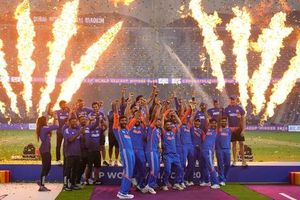England’s Red Roses have once again etched their names into the history books, clinching a thrilling 33-13 victory over Canada in the Women’s Rugby World Cup final on September 27, 2025, at the iconic Allianz Stadium in Twickenham. It was a night of firsts, records, and a celebration of women’s sport that reverberated far beyond the pitch. With a roaring crowd of 81,885—shattering all previous attendance records for a women’s rugby match—the stage was set for a spectacle, and the teams delivered in style.
For England, the triumph marked their third Women’s Rugby World Cup title and their first since 2014, capping off a remarkable 33-match unbeaten run. The Red Roses, under the guidance of Coach of the Year John Mitchell, showcased a blend of grit, flair, and unity that has made them the gold standard in the women’s game. The final whistle sparked scenes of jubilation, not just among the players but also among the 82,000-strong record crowd and millions watching from home.
Ellie Kildunne, recently crowned the 2024 World Player of the Year, delivered one of the final’s defining moments. In the first half, she picked up the ball 30 metres out, sliced through Canada’s defense with breathtaking speed, and dotted down for a try that had the stadium on its feet. BBC Radio 5 Live’s Kat Merchant couldn’t contain her excitement: “She just sliced through like she had an invisible cloak on. Oh my gosh, what a wonder try.” New Zealand World Cup winner and BBC pundit Ruby Tui added, “The people ordered and Ellie Kildunne delivered. She was audacious with her try. Kildunne and dusted.”
But Kildunne wasn’t alone in her heroics. England’s Alex Matthews powered over for two tries, while Sadia Kabeya’s tireless work at the breakdown earned her Player of the Match honors. Amy Cokayne, too, had her best game of the tournament, racking up 68 points and cementing her place in the Fantasy All-Star team for the finals. The Red Roses’ all-around performance was a testament to their depth, preparation, and relentless spirit.
Canada, meanwhile, can hold their heads high. Led by inspirational captain Sophie De Goede—who was named Player of the Year for her outstanding leadership and skill—the Canadians pushed England throughout the contest. Asia Hogan-Rochester finished her tournament with a flourish, scoring two tries in the final and earning a spot on the fantasy team of the round. Despite operating in an amateur system and making significant personal sacrifices, Canada’s players demonstrated that they can compete with the world’s best, prompting calls for greater professional support back home.
The final was more than just a game; it was a celebration of progress, diversity, and inspiration. The tournament itself set new benchmarks in nearly every metric: a total of 444,465 tickets sold—more than triple the previous World Cup’s tally—while the final drew a record 5.8 million viewers in the UK alone. The BBC reported a total tournament reach of 12 million TV viewers and 10.5 million digital streams, underscoring the surging popularity of women’s rugby. Remarkably, half the fans in attendance had never been to a women’s rugby match before, and 95% said they planned to return.
Social media buzzed with excitement, as players’ accounts generated over 219 million views during the tournament. The Red Roses’ Instagram was flooded with praise: “Those mazey try-scoring runs of @elliekildunne will live rent-free in my head for forever. Those will change the women’s game big time,” wrote one commenter. Even the Spice Girls chimed in: “Amazing 👏👏 congratulations @redrosesrugby GIRL POWER ✌🏻 🏆.”
The economic impact was felt across the host cities. Bristol, for example, saw hotel occupancy rates soar above 90% on match weekends, highlighting the tournament’s value beyond the field. Mastercard’s research revealed that 43% of young women aged 8-25 have been inspired to try a new sport, and 37% are considering rugby, thanks to the increased visibility and the emergence of relatable role models.
Another historic milestone came off the pitch, as the Women’s Rugby World Cup final was prepared by the first all-female grounds team. The 15-strong crew, including 23-year-old Beth Gibb from Wellington School, spent three days mowing and conducting safety checks at Twickenham. “It was surreal,” Gibb said of the experience, describing her passion for the job and the therapeutic nature of working outdoors. Jennifer Carter, director of communications at the Grounds Management Association, hailed the achievement as a “landmark moment not just for rugby, but for the entire grounds management industry.” She added, “An all-female grounds team at a game of this magnitude—the biggest Women’s Rugby World Cup Final ever—shows how far we’ve come. Encouraging more women and girls to consider grounds management as a career is vital. You have to see it to be it—and we hope we’ve inspired the next generation to get involved.”
Referee Hollie Davidson also made her own piece of history, becoming the first person—male or female—to officiate two Women’s Rugby World Cup finals. Her appointment capped a week in which she received the prestigious World Rugby Referee Award, further highlighting the strides being made in women’s sport at every level.
The tournament’s breakout star was New Zealand’s Braxton Sorensen-McGee, who led the competition in tries and points and was named Breakthrough Player of the Year. The Black Ferns, for their part, claimed their first-ever World Cup bronze by defeating France 42-26, with Sorensen-McGee scoring two tries and Renee Holmes earning Player of the Match honors.
Looking ahead, the momentum shows no sign of slowing. Domestic women’s rugby leagues are kicking off fresh seasons around the world, from the Energia All-Ireland League to Spain’s Iberdrola League, while the Women’s Six Nations and HSBC SVNS Series are set to return in 2026. Scottish Rugby has announced increased investment in contracts and support for the 2025/26 season, aiming to build a sustainable domestic program leading up to the 2029 World Cup.
In a final twist of inspiration, former USA Eagle Erin Overcash was selected as a NASA astronaut candidate, becoming the third USA Rugby player to earn this distinction. Overcash, who played as a utility back and has a master’s degree in bioastronautics, will begin a two-year training program—a testament to the diverse pathways that rugby can open up.
As the confetti settled at Twickenham and the Red Roses lifted the trophy, one thing was clear: this was more than a win. It was a watershed moment for women’s rugby, a celebration of progress, and a sign that the future of the sport is brighter—and more inclusive—than ever before.






